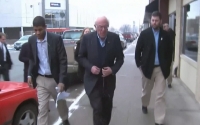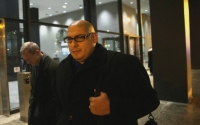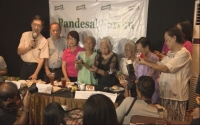One year later, the LGBT face of Superstorm Sandy still bouncing back

Carl Siciliano got the call four days after the storm of the century made landfall.
Siciliano hadn’t seen the damage that Superstorm Sandy had caused to the Ali Forney Center, the largest organization in the U.S. dedicated to homeless lesbian, gay, bisexual and transgender youth. The drop-in center in the Chelsea neighborhood of New York was located a half of a block away from the Hudson River. The landlord of the building told Siciliano that the floodwater came up to the front desk of the center’s lobby. At first, Siciliano was slightly relieved, thinking there would only be minimal damage.
But then he received another call from two staff members who jogged from Brooklyn to Manhattan's West 22nd Street to see the damage firsthand. They found it in ruins.
Four feet of water had overwhelmed the facility. The floors had buckled and the electrical outlets were full of saltwater that came over from Chelsea Piers, roughly 1,300 feet from the center. The medical supplies were compromised and food was rotting in the floodwater. Desks were submerged and records and files were left unreadable. The devastation left the center uninhabitable, forcing Siciliano and his staff to scramble to find refuge for the 30 to 40 homeless LGBT youths the center usually saw on a daily basis.
"It didn’t occur to us that our space would be inundated with four feet of water and that the storm would destroy the building," Siciliano says. "We weren’t really planning for that."
What also wasn’t planned was the response that followed, one that would turn the Ali Forney Center into one of the feel-good stories to come out of the Sandy relief effort – and help reignite the larger conversation around homeless LGBT youth in New York.
'We became hot'

Founded in 2002, the Ali Forney Center has become the largest organization in the country dedicated to homeless LGBT youth. Of the estimated 350 beds dedicated to homeless LGBT youth in the U.S., the center operates about a fourth of the nationwide total. It will run 89 beds among several buildings throughout New York by this Thanksgiving.
Homeless LGBT youth groups already faced a difficult funding climate before Sandy hit, said Kimberly Forte, a supervising attorney for the LGBT Law and Policy Initiative at the Legal Aid Society of New York City. Since 2008, New York state's spending on beds and services for runaway and homeless youths has been cut more than half, down to $745,000 a year.
"This crisis, which is now at its worst, has been building and building and building over the last decade,” Forte said. “I have no doubt Sandy had a tremendous impact on homeless LGBT youth throughout the entire city.”
For many organizations supporting homeless youth as a whole, the storm's devastation was a tough pill to swallow.
“Many organizations are operating on a shoestring budget and have been struggling,” says Jama Shelton, director of the Forty to None Project at the True Colors Fund, an organization fighting to end homelessness among LGBT youth. “Even if a drop-in center wasn’t flooded, the fact their electricity was out means they lost all their food and medication. For a small program that’s maybe struggling to keep their doors open, that’s devastating.”
Most urgently, the center needed to find refuge for the youths who regularly hung out there. The 1,200-square-foot space on West 22nd Street had become so moldy that it would take two weeks for a remediation crew to figure out what was destroyed and what the damages would be. Soon, Siciliano would give an update on the state of the center, pleading for assistance.
What happened next helped turn the Ali Forney Center into the LGBT face of Sandy. In a 10-day period, Siciliano says he did about 50 interviews. Influential gay blogger Joe.My.God picked up the story, as did The New York Times, The New Yorker, The Associated Press, the Los Angeles Times, the Washington Blade and the LGBT blog Queerty. Actors from Joseph Gordon-Levitt to Pam Grier tweeted and retweeted support for the center.
"The special thing about Sandy was that it was in a top media market in a very populated area," says Ben Smilowitz, director of the Disaster Accountability Project, a group that advocates for improving disaster management systems. "That allowed for gaps to be found faster and identified faster, and when gaps are exposed, they are addressed."
The response to the Ali Forney Center’s story was like nothing it had seen before. The center receives between $250,000 and $500,000 in donations each November and December, the holiday donation season. But in the first 36 hours after the post on Joe.My.God, the center received more than $100,000 in donations. Soon, the total was $400,000. In all, the center received about $1 million in donations right after Sandy, Siciliano says. It remains unclear how much of the bounce was specifically motivated by Sandy or how much of it was because of the center’s elevated profile. A year later, Siciliano is still unsure why or how the center received that level of attention.
“We became hot,” Siciliano says. “It was like we were the hot charity for like two months and that had never happened to me before. I didn’t know what that was like.”
An historic crisis

In the year since Sandy, there's been more attention on New York’s homelessness rate and Mayor Michael Bloomberg’s legacy on the issue. In March, the Coalition for the Homeless released its State of the Homeless 2013 report, which detailed how New York’s homeless shelter system housed an average of more than 50,000 people a night in January, representing a 19-percent spike from 2012 and a 73-percent increase since the beginning of Bloomberg’s tenure as mayor. And when it comes to youth homelessness, the situation is just as dire. On average, more than 21,000 children sleep in homeless shelters per night, accounting for 1 percent of children in New York.
"New York City’s next mayor," the report stated, "will confront a historic homelessness crisis."
There are just 250 city-financed youth shelter beds, covering less than 7 percent of the estimated 3,800 homeless youth on the streets. A lack of beds has forced places like the youth shelter Covenant House to turn away between 200 to 400 children a month, according to The New York Times.
The Bloomberg administration’s public response to homelessness has been curious. In February, the mayor's “nobody’s sleeping on the streets” comment had critics painting him as being out of touch. Last week, Deputy Mayor Linda Gibbs, in charge of Health and Human Services, defended the administration’s role in fighting homelessness in the New York Daily News.
"Mayor Bloomberg’s administration has tried more and done more to help the homeless than any other," Gibbs wrote, "and it has worked: Street homelessness is down by two-thirds."
But with every defense of the mayor’s work on youth homelessness, the criticism grows louder. Last week, The New Yorker reviewed the increased homelessness rate under Bloomberg, and what the next mayor can do to turn around a situation that’s as dire as it has been in decades. One of those options is the Campaign for Youth Shelter, which calls on the next mayor to add 100 youth shelter beds until there is no longer a waiting list. Mayoral candidate Bill de Blasio, the overwhelming favorite to be the next mayor, has signed onto the plan. For now, there’s hope that the homeless youth population can’t possibly inflate any further.
"Could you imagine if [New York Police Commissioner] Ray Kelly had crime reaming out of control the way like how it has been with youth homelessness? He’d be long gone," says Mary Brosnahan, president of the Coalition for the Homeless. "But there’s not the same ruler used when it comes to the devastation of poor, young, homeless people."
A new home

The Ali Forney Center's new home is above a Popeye’s Fried Chicken in Harlem. Located at the corner of West 125th Street and St. Nicholas Avenue, the 8,000-square-foot space is still a work-in-progress. The hardwood floors are incomplete and the showers have yet to be installed, but the center has some essentials, including a new kitchen featuring a dedicated cook.
The move to the uptown location was scheduled before Sandy, but the storm created more hurdles, especially given the state of the Chelsea facility. The plan was to stay in the old space until the lease ran out in January, but the weeks following Sandy led to emergency construction at the Harlem location. Some of the Center’s regular drop-ins who had temporarily migrated to the reserved space at the LGBT Center were, for one reason or another, not coming as often, down from around 30 to 40 people to about a dozen a day. Growing worried about where the center’s regular visitors were staying in the colder weather, Siciliano and his staff managed to open the new location on Dec. 22, attracting between 50 to 70 youths a day.
One of them is Misha, a 24-year-old Trinidadian native from Virginia. Misha, who is transgender, was 19 when she first started coming to the Ali Forney Center, right around the time her grandmother kicked her out of the house because of the noticable changes to her body due to Misha's hormone intake. After her purse was stolen, Misha went two years without any form of identification, making it even more difficult to live day to day. By the time she was finally able to get her birth certificate, she decided to keep it safe with the drop-in center on West 22nd Street. When the storm flooded the area, her birth certificate was destroyed.
"Sandy took away me getting my identity back," Misha says. "I just got it back and then, it was gone."
In a common room of the center, groups of youth talk and participate in activities – some watching YouTube videos, others playing card games. With the 2010 Report of the New York City Mayoral Commission for LGBTQ Runaway and Homeless Youth indicating that 20 percent of New York’s homeless LGBT youth population is infected with HIV, there’s a good chance, statistically, that one or more of the kids who drop by are living with the disease.
"Their lives were horrible before the hurricane and their lives are horrible after the hurricane," Siciliano says. "We were struggling to get the resources to take care of them before the hurricane and we’re struggling to get the resources to take care of them after the hurricane. It hit us hard in our ability to do that in the short-term, and it has also hit us over the long-term."
The center isn’t done just yet, but officials are hoping to get showers and an on-site medical facility running by next spring. Even with the windfall of donations from last year, a $25,000 from the Robin Hood Foundation and a recently approved $320,000 federal relief grant, expenses with the new building, the renovation and the need to replace and maintain resources, food and medicine has proven to be a costly venture since the storm. They’ve been approved for FEMA money, but a year later, Siciliano says it remains unclear how much they’ll actually receive.
A year later, Siciliano understands that this year’s donations may not hit the $1 million mark like last year. But even if 20 percent of the people who donated last year do so again this year, it could potentially be “transformative” for the country’s biggest homeless LGBT youth center.
"I was very grateful," he says of the response the center received following Sandy. "I was very surprised by the level of response. We were in a desperate place."












Error
Sorry, your comment was not saved due to a technical problem. Please try again later or using a different browser.